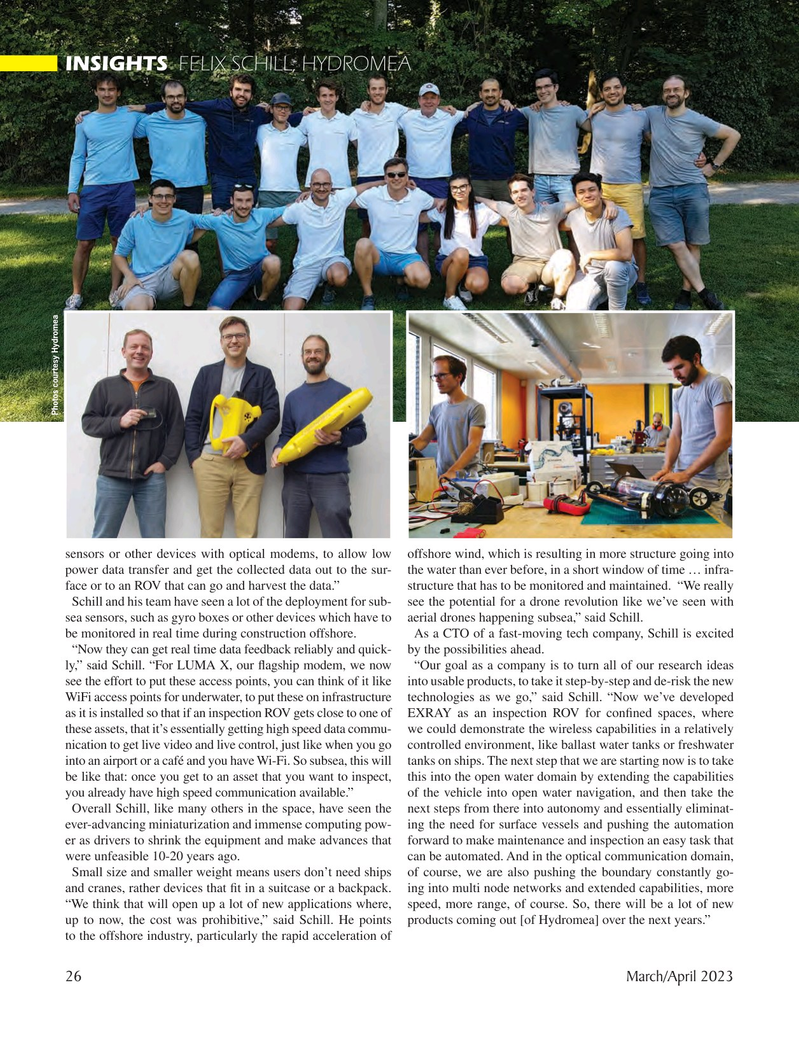
Page 26: of Marine Technology Magazine (March 2023)
Read this page in Pdf, Flash or Html5 edition of March 2023 Marine Technology Magazine
INSIGHTS FELIX SCHILL, HYDROMEA
Photos courtesy Hydromea sensors or other devices with optical modems, to allow low offshore wind, which is resulting in more structure going into power data transfer and get the collected data out to the sur- the water than ever before, in a short window of time … infra- face or to an ROV that can go and harvest the data.” structure that has to be monitored and maintained. “We really
Schill and his team have seen a lot of the deployment for sub- see the potential for a drone revolution like we’ve seen with sea sensors, such as gyro boxes or other devices which have to aerial drones happening subsea,” said Schill.
be monitored in real time during construction offshore. As a CTO of a fast-moving tech company, Schill is excited “Now they can get real time data feedback reliably and quick- by the possibilities ahead. ly,” said Schill. “For LUMA X, our ? agship modem, we now “Our goal as a company is to turn all of our research ideas see the effort to put these access points, you can think of it like into usable products, to take it step-by-step and de-risk the new
WiFi access points for underwater, to put these on infrastructure technologies as we go,” said Schill. “Now we’ve developed as it is installed so that if an inspection ROV gets close to one of EXRAY as an inspection ROV for con? ned spaces, where these assets, that it’s essentially getting high speed data commu- we could demonstrate the wireless capabilities in a relatively nication to get live video and live control, just like when you go controlled environment, like ballast water tanks or freshwater into an airport or a café and you have Wi-Fi. So subsea, this will tanks on ships. The next step that we are starting now is to take be like that: once you get to an asset that you want to inspect, this into the open water domain by extending the capabilities you already have high speed communication available.” of the vehicle into open water navigation, and then take the
Overall Schill, like many others in the space, have seen the next steps from there into autonomy and essentially eliminat- ever-advancing miniaturization and immense computing pow- ing the need for surface vessels and pushing the automation er as drivers to shrink the equipment and make advances that forward to make maintenance and inspection an easy task that were unfeasible 10-20 years ago. can be automated. And in the optical communication domain,
Small size and smaller weight means users don’t need ships of course, we are also pushing the boundary constantly go- and cranes, rather devices that ? t in a suitcase or a backpack. ing into multi node networks and extended capabilities, more “We think that will open up a lot of new applications where, speed, more range, of course. So, there will be a lot of new up to now, the cost was prohibitive,” said Schill. He points products coming out [of Hydromea] over the next years.” to the offshore industry, particularly the rapid acceleration of 26 March/April 2023
MTR #3 (18-33).indd 26 3/17/2023 5:59:33 PM

 25
25

 27
27
